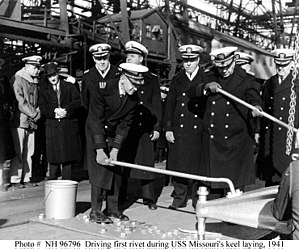Shipbuilding is the construction of ships and other floating vessels. It normally takes place in a specialized facility known as a shipyard. Shipbuilders, also called shipwrights, follow a specialized occupation that traces its roots to before recorded history.
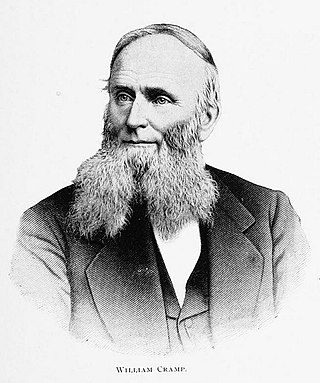
William Cramp & Sons Shipbuilding Company of Philadelphia was founded in 1830 by William Cramp, and was the preeminent U.S. iron shipbuilder of the late 19th century.
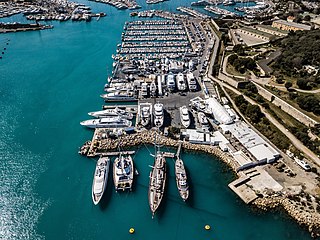
A shipyard, also called a dockyard or boatyard, is a place where ships are built and repaired. These can be yachts, military vessels, cruise liners or other cargo or passenger ships. Dockyards are sometimes more associated with maintenance and basing activities than shipyards, which are sometimes associated more with initial construction. The terms are routinely used interchangeably, in part because the evolution of dockyards and shipyards has often caused them to change or merge roles.

The SIGMA class is a Dutch-built family of modular naval vessels, of either corvette or frigate size, designed by Damen Group.

Charleston Naval Shipyard was a U.S. Navy ship building and repair facility located along the west bank of the Cooper River, in North Charleston, South Carolina and part of Naval Base Charleston.

USS Gerald R. Ford (CVN-78) is the lead ship of her class of United States Navy aircraft carriers. The ship is named after the 38th President of the United States, Gerald Ford, whose World War II naval service included combat duty aboard the light aircraft carrier Monterey in the Pacific Theater.
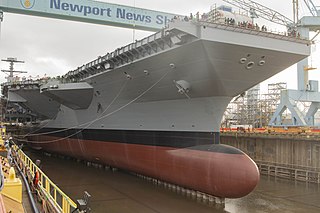
USS John F. Kennedy (CVN-79) is the second Gerald R. Ford-class aircraft carrier built for the United States Navy. The ship was launched on 29 October 2019, and christened on 7 December 2019.

MILGEM project is a national warship program of the Republic of Turkey. Managed by the Turkish Navy, the project aims at developing multipurpose corvettes, frigates and destroyers that can be deployed in a range of missions, including reconnaissance, surveillance, early warning, anti-submarine warfare, surface-to-surface and surface-to-air warfare, and amphibious operations.
The coin ceremony is an event which takes place at the keel laying, in the early stages of a ship's construction. In it, the shipbuilders place one or two coins under the keelblock of the new ship to bless the ship and as a symbol of good fortune. The coins are not normally fixed in place and are often retrieved when the ship sails out of the dry-dock,.

Brodosplit is the largest shipyard in Croatia, located in the Supaval bay, on the north side of the Split peninsula.

The Makassar class is a class of South Korean-designed Landing Platform Dock. The lead ship is named after the city of Makassar in Sulawesi and built in Busan, South Korea. The ships were designed by Daesun Shipbuilding & Engineering Co. based on their earlier design of Tanjung Dalpele class that was sold to the Indonesian Navy.

The Bradleys Head Fortification Complex is a heritage-listed former mast and defensive battery and military fortification and now war memorial and recreational area located at Bradleys Head Road within the Sydney Harbour National Park in Mosman in the Mosman Council local government area of New South Wales, Australia. It was designed by Government engineers and built from 1840 to 1934. It is also known as Bradleys Head Forts and HMAS Sydney 1 Mast and Associated Memorials. The property is owned by the NSW Office of Environment and Heritage, an agency of the Government of New South Wales. It was added to the New South Wales State Heritage Register on 30 August 2010.

The Karachi Shipyard & Engineering Works Limited (KS&EW) is a Pakistani state-owned defense contractor and military corporation situated in the West Wharf in Karachi, Sindh in Pakistan.

HMS Reindeer was a Royal Navy Mariner-class composite screw gunvessel of 8 guns.

Harry DeWolf-class offshore patrol vessels are warships of the Royal Canadian Navy (RCN) built within the Government of Canada Arctic and Offshore Patrol Ship (AOPS) procurement project, part of the National Shipbuilding Procurement Strategy. In July 2007 the federal government announced plans for acquiring six to eight icebreaking warships for the RCN.

Mast stepping is the process of raising the mast of a boat. It may be a ceremonial occasion on a new boat, a necessary step, or simply routine.

The Nilgiri-class frigates, formally classified as the Project-17 Alpha frigates (P-17A), are a series of stealth guided-missile frigates currently being built by Mazagon Dock Shipbuilders (MDL) and Garden Reach Shipbuilders & Engineers (GRSE), for the Indian Navy.

The Samuel Beckett-class offshore patrol vessel is a class of offshore patrol vessels (OPV) ordered by the Irish Naval Service from October 2010. The first vessel is named Samuel Beckett and was commissioned in May 2014. Construction on this first vessel commenced in November 2011, A further three vessels were named James Joyce, William Butler Yeats and George Bernard Shaw, and delivered in 2015, 2016 and 2018 respectively.

USS Enterprise (CVN-80) will be the third Gerald R. Ford-class aircraft carrier to be built for the United States Navy. She will be the ninth United States naval vessel and third aircraft carrier to bear the name, and is scheduled to be in operation by 2028. Her construction began in August 2017 with a steel-cutting ceremony.
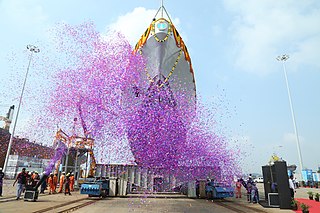
The Anti-Submarine Warfare Shallow Water Craft (ASW-SWC) corvettes, are a class anti-submarine warfare vessels currently being built for the Indian Navy, by Cochin Shipyard (CSL) and Garden Reach Shipbuilders & Engineers (GRSE). They were conceived as a replacement to the ageing Abhay-class corvettes of the Indian Navy, and are designed to undertake anti-submarine warfare (ASW) duties – including subsurface surveillance in littoral-waters, search-and-attack unit (SAU) missions and coordinated anti-submarine warfare operations with naval aircraft. They were also designed to provide secondary duties – including defense against intruding aircraft, minelaying and search-and-rescue (SAR).
